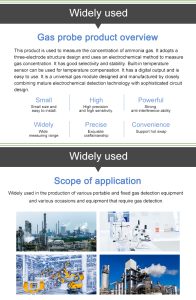-
Revolutionizing Gas Detection Technology: The Power of Gas Sensors in Ensuring Safety
- Gas leaks can have severe consequences, ranging from explosions and fires to health hazards. To mitigate these risks and ensure safety in various industries, gas detection technology has undergone a revolution with the advent of gas senso……
- Chat Online
-
Description
Gas leaks can have severe consequences, ranging from explosions and fires to health hazards. To mitigate these risks and ensure safety in various industries, gas detection technology has undergone a revolution with the advent of gas sensors. This article explores how gas sensors are revolutionizing gas detection technology, their significant impact on safety measures, and their role in various industries.
The Importance of Gas Detection:
Gas leaks, whether they occur in industrial settings, commercial buildings, or residential areas, pose serious threats to life, property, and the environment. Detection of hazardous gases is essential for early warning and prompt actions to prevent accidents and protect lives. Traditional methods like visual inspection or human olfaction are not reliable and efficient in detecting low levels of invisible and odorless gases.
Gas Sensors for Gas Detection:
Gas sensors have emerged as a game-changing technology in gas detection systems. These sensors use various technologies such as electrochemical, semiconductor, infrared, and ultrasonic to detect and measure the presence and concentration levels of hazardous gases. Some commonly detected gases include carbon monoxide (CO), methane (CH4), hydrogen sulfide (H2S), ammonia (NH3), and volatile organic compounds (VOCs).
Advantages of Gas Sensors:
Gas sensors offer several advantages over traditional gas detection methods:
a) Accuracy and Sensitivity: Gas sensors provide high accuracy and sensitivity in detecting even minute concentrations of hazardous gases. They can detect gases in real-time, enabling immediate responses to potential dangers.
b) Real-time Monitoring: Gas sensors continuously monitor the surrounding environment, providing real-time data on gas concentrations. This allows for proactive measures and prompt response to gas leaks or abnormal levels, minimizing the risk of accidents.
c) Alarm Systems: Gas sensors are integrated with alarm systems that trigger audible and visual alerts when gas concentrations exceed predefined thresholds. This ensures that workers, occupants, or nearby personnel can quickly evacuate or take appropriate actions.
d) Data Logging and Analysis: Many gas sensors have the capability to log data, allowing for historical analysis of gas levels and trends. This information aids in identifying recurring issues, improving safety protocols, and optimizing maintenance schedules.
Application Areas: Gas sensors are revolutionizing safety measures in several industries and scenarios:
a) Industrial Safety: Gas sensors are extensively used in industries such as oil and gas, chemical processing, mining, and manufacturing to detect and monitor hazardous gases. By promptly detecting leaks or abnormal gas levels, potential accidents can be prevented, ensuring worker safety.
b) Residential and Commercial Buildings: Gas sensors are integrated into home and commercial building automation systems to detect gas leaks from sources like natural gas pipelines, propane tanks, or faulty appliances. Early detection can prevent fire or explosion hazards, safeguarding occupants' lives.
c) Environmental Monitoring: Gas sensors are employed in environmental monitoring stations or air quality monitoring systems to detect pollutant gases and assess their impact on the surrounding environment. This helps in implementing pollution control measures and protecting ecosystems.
Further Advancements and Challenges: Gas sensor technology continues to evolve with advancements in miniaturization, wireless connectivity, and data analytics. However, there are still challenges that need to be addressed:
a) Sensor Calibration and Maintenance: Proper calibration and regular maintenance of gas sensors are necessary to ensure accurate and reliable measurements. Periodic recalibration and verification procedures are essential to maintain performance.
b) False Alarm Management: Gas sensors need to strike a balance between sensitivity and false alarm rates. Minimizing false alarms due to environmental factors like humidity, temperature changes, or dust particles is crucial for practical implementation.
c) Compatibility and Integration: Integrating gas sensors with existing safety systems, such as fire alarm systems or building management systems, can enhance overall safety measures. Ensuring compatibility and seamless integration pose challenges that need to be overcome.
Conclusion:
Gas sensors have revolutionized gas detection technology and significantly improved safety measures across industries. Their accuracy, real-time monitoring capabilities, and integration with alarm systems have played a vital role in mitigating risks posed by hazardous gases. Continued advancements in gas sensor technology, alongside addressing challenges related to calibration, false alarms, and integration, will further enhance safety measures, ensuring the well-being of workers, occupants, and the environment. The power of gas sensors in ensuring saf
-
Recommend:
-
-
Gas detectors are crucial devices used in various industrie…
-
How do gas detectors ensure industrial safety?
Gas detectors play a crucial role in ensuring the safety of…
-
How Gas Sensors Help Combat Air Pollution?
Air pollution is a pressing global issue that poses signifi…
-
How can gas sensors be used in air quality monitoring?
Air pollution is a significant global concern that affects …
-
 : +86 155 8830 2704
: +86 155 8830 2704 : jxdziot@gmail.com
: jxdziot@gmail.com
